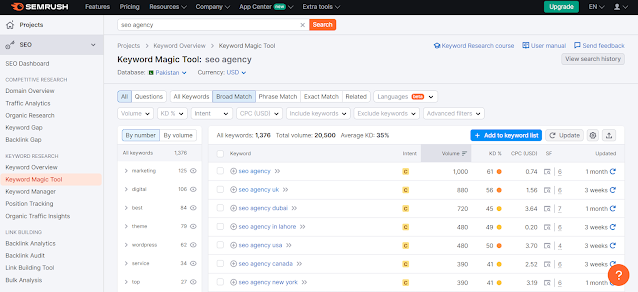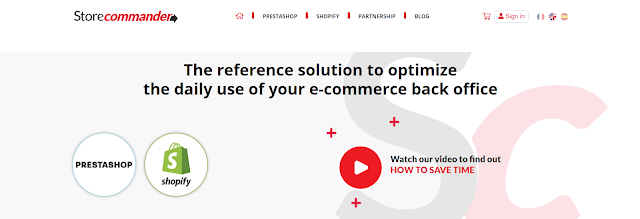5 Tools to Find Competitor Keywords
Everyone who owns a website has a common goal: to increase traffic to obtain more conversions. Bringing Internet users to your site requires time and investment in an SEO strategy.
Also, to reach the first search results, you will necessarily have to, at one point or another, get ahead of your competitors. To achieve this, it is crucial to have information about their SEO techniques.
Analyzing the keywords used by your competitors will allow you to develop your strategy and identify the resources you will need to outperform them. Let's now look at the different steps to follow to identify competitive keywords.
The tools in this article were selected by our team and are not sponsored. Find out how to sponsor your tool.
Tools for finding competitors’ keywords
Here is a list of 5 tools to know to highlight competitor keywords.
1. Google Keyword Planner
When it comes to keyword research, Google Keyword Planner is an interesting tool to know because it is complete and above all free. In fact, a Google account is enough to access it, given that it is integrated into the AdWords advertising network.
To find the keywords of competitors, Just enter their site URL and click “Get Ideas”. In a few seconds, the Google Keyword Planner will give you a list of keywords that are associated with the page.
It's up to you to know how to use this data wisely!
2. Majestic SEO
This is another particularly relevant tool for understanding your competitors’ SEO strategy.
Majestic SEO relies more on the links and anchors used. However, the anchors most often correspond to the keywords on which the company wishes to position itself.
Therefore, by analyzing the most used link anchors, it is easy to identify a competitor’s keywords.
3. SEMRush
Those who are closely interested in SEO know how powerful the tools made available by SEMRush are. However, to take full advantage of all the features, the cost is high.
However, if you only want to obtain the keywords of your competitors, insert the URLs of your rivals' sites and you will obtain a list of them with the number of visits that each has managed to generate.
You will also obtain the results page on your competitor's site for the different keywords.
So much relevant data to analyze to, in turn, make the right SEO decisions.
4. SpyFu
Particularly easy to use and free, SpyFu allows you to very easily obtain the keywords on which your main ones are positioned, competitors.
To do this, simply enter their URL into the tool. This will scan the sites and present you with a list of keywords.
You will then have to make good use of the information obtained.
5. Ubersuggest
Ubersuggest undoubtedly offers one of the most beautiful databases on the Web. This is why we offer you this tool, although it does not have the reputation of some others presented here.
While it allows you to easily obtain your competitors’ keywords, it also allows you to “test” keywords. Enter a query on which you wish to position yourself and you will very quickly know whether your main competitors are well positioned or not on it.
We may therefore regret that this tool is limited to the results of the first page of Google, but it is worth a detour all the same.
Steps to Building Your Strategy
1. Identify your competitors
It goes without saying that there is no point in launching a competitive analysis if you do not know your competitors. If you own an e-commerce site, you should consider big brands such as Amazon as your competitors.
Start by doing a simple Google search with the keywords you want to rank for. This reveals the brands playing on the same playing field as you: you will be able to visualize their position.
Large companies often dominate the top of the rankings, both in organic results and in paid results. Also, if your domain name does not yet have much authority, it may be more reasonable to target weaker competitors.
You can also use SEMrush to identify your competitors. To do this, simply enter your URL, then scroll down to the “Top Organic Competitors” section. By clicking on “Read the detailed report” you have access to the entire list of your competitors.
In particular, you can visualize the level of competition as well as the traffic on their website.
2. Find your competitors’ keywords
Now that you've identified the competitors you want to overtake, it's time to take a closer look at their SEO strategy, and that starts with identifying their keywords.
Keywords are the key to driving traffic to your site. You must therefore choose those on which you wish to position yourself. Even if you use Google’s Keyword Planner, you should consider the competition.
This strategy allows you to use keywords that are already bringing traffic to your competitors. It's then up to you to use them judiciously to redirect Internet users to your own site.
On SEMrush, enter the URL of one of your competitors. Go to “Domain Analysis”, and then “Organic Search” from the navigation bar on the left. From the “Positions” tab, you can export the list of keywords used by the brand.
The list of keywords is certainly big. So eliminate those that are not relevant to your product or service.
3. SEO content strategy and audit of your competitors
The audit of the most ambitious pack includes the semantic SEO audit of your main competitors to detect the keywords on which they are positioned and offer you relevant content to position yourself on these competitive searches.
The semantic audit of your site and your competitors allows you to detect the best keywords to design content topics. An SEO expert takes care of this and submits it to you for validation. Finally, the content is written, optimized for natural referencing, and delivered to you in HTML format to allow you to integrate it quickly and easily into your website.
4. Make groupings
Your list should normally contain generic keywords. For example, if you own a hair salon you will certainly have terms such as “hairdressing”, “hairdresser”, “haircut”, etc. It is often very difficult to beat your competitors on these kinds of keywords. These are extremely competitive.
The ideal is therefore to group generic keywords with other more precise terms to obtain more precise key expressions. specific and more adapted to your target.
5. Explore paid keywords
By doing some Google research, you may find that your competitors are using ads to boost their traffic.
Even if you don't want to invest in campaigns of this type, it is recommended to identify the keywords that brands use in these ads. You will be able to position yourself on it through your SEO to give yourself more credibility.
6. To go further…
Developing a list of keywords and targeting them organically is not enough to outperform your competitors. In reality, this list gives you access to a lot of other information that you should use.
By performing a search for each of the keywords in your list, you can identify the quality and relevance of the content associated with it.
You can also judge the user experience of the sites arriving in the first positions. Thanks to the Google Mobile-Friendly tool, you can test responsiveness. For load time, you can use PageSpeed Insights.
By gradually identifying the weaknesses of each of your competitors, you will be able to improve your site and your content so as not to repeat the same mistakes.
Our tip
Analyzing your competitors’ keywords allows you to know what is really relevant to your target audience. Instead of guessing their queries, you know the searches they are likely to conduct.
Being well-positioned in Google results is essential for a business. Also, before implementing any SEO strategy, take the time to use the different tools that we have presented to you and, if necessary, call OMT for the best SEO services in Lahore.








Comments
Post a Comment